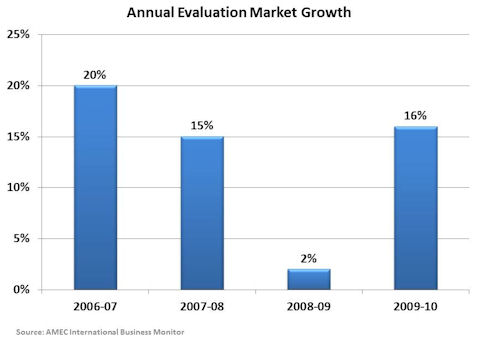Despite, or maybe in part because of the recession, companies are investing more in tools to measure the effectiveness of their PR and media efforts. According to figures from the Association for the Measurement and Evaluation of Communication (AMEC), the market for media evaluation grew 16 per cent from 2009 to 2010, continuing a trend in growth that goes back to at least 2006.
Annual Evaluation Market Growth Rate

Marcus Gault, managing director of insight at Precise, says that he is not surprised that the PR sector is working harder to be more accountable: “PR is quite a subjective discipline, so it is important that PROs show what value they are adding to the organisation. Evaluation helps them to highlight the return on investment that PR offers.“ Gault points out that PR is not alone in focusing on proving its worth. He adds: “A lot of service departments in the last five to ten years have felt pressure to demonstrate their effectiveness.”
These days it is much simpler to get regular, accessible and timely evaluation reports. Ten years ago evaluation was usually offered on a quarterly basis, but now you can demand weekly, or even daily reports. Gault says this means that evaluation is more relevant than before: “Rather than seeing a reflection of the past, you can now look at what's going on today, so if you discover a possible problem bubbling under, you can nip it in the bud. Evaluation today helps PROs manage the here and now as well as longer-term reputation challenges.”
Discussing why directors are spending more on PR evaluation during a recession, Gault says that despite the fact that clients have less money to spend, there is greater pressure to prove the value of PR: “As PR and marketing are non-core business activities, they need to demonstrate their value to the organisation, and find clear evidence that PR activity delivers a strong ROI“. As today’s evaluation reports are more straightforward than the more cumbersome methods of the past, PROs find they help them argue their case. “It is much easier to put a two-page dashboard in front of a director than show him or her a pile of newspaper cuttings. It distils the value into a format that is easily understood by directors.”
PR Masterclass: The Intersection of PR and GEO
Join PRmoment for a Masterclass featuring 10 of the industry’s foremost experts. You will walk away with a clear, actionable strategy for adapting your content to an AI-first search environment.
Taking place on Wednesday 25th February in London, both virtual and in person tickets are available.
Early bird ticket sale ends Friday 9 January.
PR MasterclassIf you enjoyed this article, sign up for free to our twice weekly editorial alert.
We have six email alerts in total - covering ESG, internal comms, PR jobs and events. Enter your email address below to find out more:









